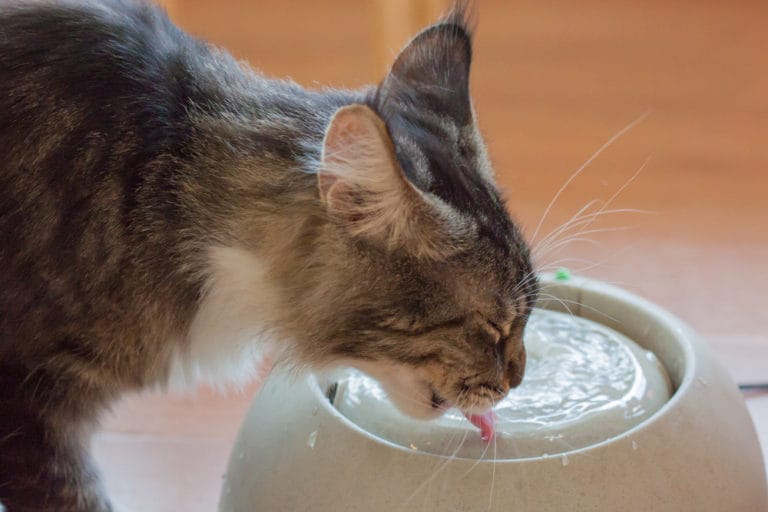You’ve probably seen funny videos and memes of fat dog and fat cats on social media. But pet obesity is no laughing matter.
An estimated 60 percent of cats and 56 percent of dogs in the United States are overweight or obese, according to the Association for Pet Obesity Prevention’s 2018 survey.
Excess weight is unhealthy for our pets, and can lead to diabetes, arthritis, high blood pressure and heart disease.
So, it’s in our pets’ best interest to keep them at a healthy weight. We spoke with Zay Satchu, DVM, co-founder and chief veterinary officer at Bond Vet in New York, to get tips on how to manage our pets’ weight.
Q:
What is a healthy weight for a cat?
A: This is such a great question and one I wish I could answer with a factual, straight forward answer. The tricky part is that, similar to humans where we look at our BMIs [Body Mass Index], which are based on age, height, etc., there are many factors to consider. My rule of thumb is that I want to be able to feel over top of their rib cage and not have any difficulty feeling for each individual rib. I also want to be able to see a waist when I look at them from a bird’s eye view.
If you’re looking for a hard number, most cats sit somewhere between 7-15 pounds. One of my cats is 15 pounds and he’s a little skinny. I have another who’s 7 pounds and she’s perfect. I’ve never met a 20-pound cat who wasn’t overweight.
Q:
How can I help my dog lose weight?
A: Dogs rely on us for food and activity, so we are completely in control of helping them achieve a good and healthy weight.
I usually recommend three things:
1. Increase Exercise.
Weight loss is really just math— energy in and energy out. Use more energy and you’ll lose weight. There are some dogs who love walks and trips to the park, playing fetch and running off leash. Adding an extra 45 minutes of this, 5 days a week will substantially move the needle forward on your pet’s weight loss journey.
Sometimes this is as simple as hiring a dog walker for an extra 3-5 walks a week for 1-2 months to help get their weight down.
Don’t be afraid to think outside the box. For example, swimming is great for chunky dogs who may have some arthritis that makes running on cement difficult. Another fun activity is hikes. Hikes are fantastic for both dogs and humans.
2. Adjust their food and treats.
Depending on how much weight your pet needs to lose and how quickly, many prescription weight loss pet foods will be your best friend. I’ve personally helped hundreds of animals with these. They’re balanced and usually have a lot of fiber in them, so our dogs feel full, but are still losing weight. Think of it like eating bran cereal for every meal. Note: They aren’t all as palatable as some other pet foods, so you may need to try a few options.
Slow feeders help dogs who love their food slow down while eating, which sometimes helps them feel fuller quicker. If the feeder toy or puzzle is really tricky, this helps to exhaust their mind, which can also help. It’s having to work for a meal versus going to an all-you-can-eat buffet!
Cut out the treats or find alternatives. This is the hardest for most people, but it’s usually the best way. Find low-calorie versions of the same kinds of treats, or ones with minimal fillers.
3. Take your pet to the vet for a health check.
I can’t tell you how many dogs I’ve diagnosed with hypothyroidism, [a condition in which the thyroid gland doesn’t produce enough of the hormones that regulate the metabolism, which can result in weight gain]. If you’re having a tough time, look into this along with their liver, kidney and white and red blood cell values. There may be a clue in there somewhere.
Q:
What are a few ways that I can increase my pet’s physical activity?
A: I like the idea of adding in 3-5 extra walks a week.
Other ideas include:
- Taking a tennis ball to a tennis court and tossing it around for 20 minutes
- Bringing another dog along with you on your walks—your dog is likely to have more fun
- Off-leash time at a local fenced in dog park
- Doggy day care (adding this in once or twice a week even)
- Feeder toys where they have to work for their food
- Hiking
- Swimming
Q:
What ingredients/characteristics of food should I consider for my pet’s weight management?
A: The ingredients specifically aren’t as important as the calorie content and the quantity of food you’re feeding. That being said, I like fresh food options more, and we know in human medicine, the less preservatives the better.
High fiber foods will naturally help more.
The big recommendation from me from a food perspective is that, as vets, we are taught to look on the back of any bag of food for the AAFCO [Association of American Feed Control Officials] guarantee. This tells you this particular food is balanced in protein, carbs, fat, minerals and electrolytes.
Q:
Why is my dog suddenly gaining weight?
A: It’s possible your dog has an issue with their thyroid, is being fed more than they should, isn’t getting the exercise they should or, potentially, it just looks like he or she is getting fat but it’s something else.
Pregnant dogs look fat, dogs with issues with their adrenal glands look fat. I recently treated a dog with an issue with their trachea where their skin had filled up with air—but the owners came in because they thought he looked like he was gaining weight!
See a vet, first and foremost. We’re the right people to help you through that decision-making process.
Share:









